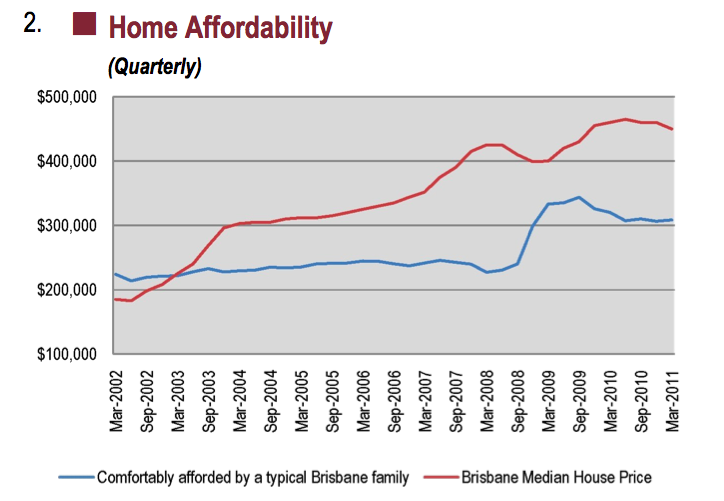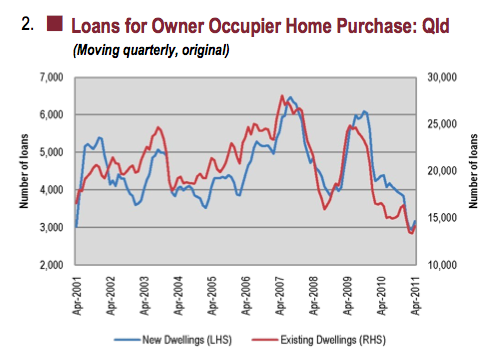The Urban Development Institute Australia – Queensland division has released its report (available at the bottom of the post ) on its expectations for the building industry in Queensland over the coming year. Their press release summarises the report.
While the June report is still dominated by bleak fundamental building activity figures, the Institute has pointed to various conditions and some early signs that the industry has bottomed and is likely to begin a bottom-up recovery led primarily by first home buyers.
While dwelling approvals have slid a further 18 per cent over the quarter, the most recent monthly observations show approvals are up on the lows of January and February. Full-time construction jobs were down 4090 in the May (reported) quarter, however, a rise in part-time construction employment of 6663 has resulted in an aggregate 2573 increase in total employment numbers.
UDIA Director of Economic Research and Policy, Duncan Maclaine, said the increase in part-time construction employment should translate into full-time employment as optimism returns to the industry over the coming months.
The UDIA report records an improvement in Brisbane housing affordability, which is likely to boost first home buyer activity and, along with a resources-driven jobs recovery, improve interstate migration.
“Housing affordability has improved marginally due to a period of falling prices, strong wages growth and stable interest rates,” Mr Maclaine said.
“First home buyers are slowly coming back and are becoming an increasingly larger share of the housing loan market.
“Queensland’s first home buyer loans as a proportion of owner-occupier loans is finally at the same level as the rest of the country, having been significantly lower since February 2009.
“With house prices predicted to remain fairly flat, and the addition of a $10,000 building grant on top of the $7,000 first home owner’s grant, we would expect to see further growth in first home buyer activity.
“An improvement in the availability of finance to developers and the introduction of infrastructure charging caps will also assist, particularly in some locations,” he said.
However, the Institute has cautioned against an overly optimistic reading of the report.
“We are not out of the woods yet,” Mr Maclaine said.
In case you were wondering who the UDIA are, their home page should clear it up for you.
UDIA (Qld) is the state’s largest professional organisation representing and furthering the interests and integrity of the property development industry in Queensland. With over 1100 corporate members representing more than 3000 affiliated individuals across a range of professions, UDIA (Qld) is a highly visible peak industry body.
We have a longstanding reputation for effectively influencing outcomes in the public and private sectors to ensure a viable future for our industry and quality outcomes for the community.
I think it is pretty clear that without the $10,000 building grant from the Queensland government that press release from this group would have read very differently. I do hope that the Queensland government afforded this industry that grant with the sole purpose of employment in mind, because their own report highlights the perverse logic used by industry groups to justify their calls for help from the government in the name of ” housing affordability”.
If you take a look at page 3 of the report you will find the following chart ( that you would never see from a bank ) and the following statement.
This graph tracks the home buying power of a Brisbane family with a median family income (25 year mortgage, 10% deposit, 30% of gross income on repayments) and the median house price in Brisbane.
House prices grew strongly from 2002, creating a substantial affordability gap for a Brisbane family earning a median income with a difference of approximately $140,000 at March 2011.
Removing supply-side obstacles and reforms to reduce the excessive cost of new housing are needed to close this affordability gap.
Over the last six months, price falls combined with stable interest rates and strong wages growth has seen some narrowing of the affordability gap.
You will note that the last time the red and the blue line were closest together was just before effects of the first home buyers grant boost ( and other stimulus measures ) hit the market, as soon as it did those two lines began to move apart again. If you look closely at the graph and following paragraph on the next page of the report you may notice some correlation.
Dramatic declines in the numbers of home loans issued during 2008 reversed strongly in 2009, assisted by the FHOG boost and low interest rates. Reduction of the FHOG grant and interest rate rises caused new declines. Whilst owner occupier loans in the latest month, Apr-11, for both new and existing home purchase, are 23% higher than in Jan-11, they have not recovered to pre-flood levels. Owner-Occupier Loans for the construction or purchase of a new home were 28% lower in the April quarter compared to the same period last year, and 15% lower for established homes (excluding refinancing). There were 2,420 owner-occupier loans for new construction in the April quarter␣around 75% of long-term average levels.
As the median house price and affordability lines are now starting to head back towards each other this building industry group thanks the Queensland government for its latest handout, while stating:
“Removing supply- side obstacles and reforms to reduce the excessive cost of new housing are needed to close this affordability gap.”
hmmm… , I am certainly a supporter of removing supply-side constraints in the housing market but those two graphs alone tell me there is a much simpler solution to closing the affordability gap in Queensland… and it would be much cheaper for the Queensland taxpayer.
The full report is below for your reading enjoyment.

